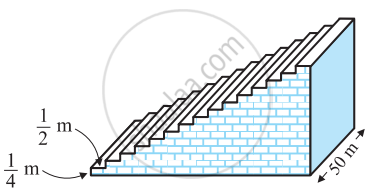Advertisements
Advertisements
Question
The sum of the third and the seventh terms of an AP is 6 and their product is 8. Find the sum of first sixteen terms of the AP.
Solution
We know that,
an = a + (n − 1) d
a3 = a + (3 − 1) d
a3 = a + 2d
Similarly, a7 = a + 6d
Given that, a3 + a7 = 6
(a + 2d) + (a + 6d) = 6
2a + 8d = 6
a + 4d = 3
a = 3 − 4d ...(i)
Also, it is given that (a3) × (a7) = 8
⇒ (a + 2d) × (a + 6d) = 8
From equation (i),
(3 - 4d + 2d) × (3 - 4d + 6d) = 8
(3 - 2d) × (3 + 2d) = 8
9 - 4d2 = 8
4d2 = 9 - 8
4d2 = 1
d2 = `1/4`
d = `± 1/2`
d = `1/2 or 1/2`
From the equation (i)
`("When" "d" 1/2)`
a = 3 - 4d
a = `3 -4(1/4)`
a = 3 - 2
a = 1
When d is − `1/2`
a = `3 - 4(-1/2)`
a = 3 + 2
a = 5
`S_n = n/2 [2a(n-1)s]`
(When a is 1 and d is `1/2`)
`S_16 = (16/2)[2"a" + (16 - 1)"d"]`
`S_16 = 8[2 xx 1 + 15(1/2)]`
`S_16 = 8(2 + 15/2)`
`S_16 = 8 xx 19/2`
S16 = 76
(When a is 5 and d is `-1/2`)
a = `3 - 4(-1/2)`
a = `3 + 4/2`
a = 5
S16 = `(16/2)[2a + (n - 1)d]`
= 8`[2(5) + 15(-1/2)]`
= `8[10 - 15/2]`
= `8 xx 5/2`
= 20
RELATED QUESTIONS
In an AP, given a = 7, a13 = 35, find d and S13.
In an AP Given a12 = 37, d = 3, find a and S12.
In an AP given a = 3, n = 8, Sn = 192, find d.
A small terrace at a football field comprises 15 steps, each of which is 50 m long and built of solid concrete. Each step has a rise of `1/4` m and a tread of `1/2` m (See figure). Calculate the total volume of concrete required to build the terrace.
[Hint: Volume of concrete required to build the first step = `1/4 xx 1/2 xx 50 m^3`]

How many terms are there in the A.P. whose first and fifth terms are −14 and 2 respectively and the sum of the terms is 40?
How many terms of the A.P. 63, 60, 57, ... must be taken so that their sum is 693?
In an A.P., if the first term is 22, the common difference is −4 and the sum to n terms is 64, find n.
Determine the A.P. Whose 3rd term is 16 and the 7th term exceeds the 5th term by 12.
The fourth term of an A.P. is 11 and the eighth term exceeds twice the fourth term by 5. Find the A.P. and the sum of first 50 terms.
Find the common difference of an AP whose first term is 5 and the sum of its first four terms is half the sum of the next four terms.
In a flower bed, there are 43 rose plants in the first row, 41 in second, 39 in the third, and so on. There are 11 rose plants in the last row. How many rows are there in the flower bed?
If the ratio of sum of the first m and n terms of an AP is m2 : n2, show that the ratio of its mth and nth terms is (2m − 1) : (2n − 1) ?
Find the first term and common difference for the A.P.
0.6, 0.9, 1.2,1.5,...
For an given A.P., t7 = 4, d = −4, then a = ______.
If the first term of an A.P. is a and nth term is b, then its common difference is
How many terms of the A.P. 27, 24, 21, …, should be taken so that their sum is zero?
The first term of an AP is –5 and the last term is 45. If the sum of the terms of the AP is 120, then find the number of terms and the common difference.
Which term of the AP: –2, –7, –12,... will be –77? Find the sum of this AP upto the term –77.
If the first term of an A.P. is 5, the last term is 15 and the sum of first n terms is 30, then find the value of n.
Assertion (A): a, b, c are in A.P. if and only if 2b = a + c.
Reason (R): The sum of first n odd natural numbers is n2.
